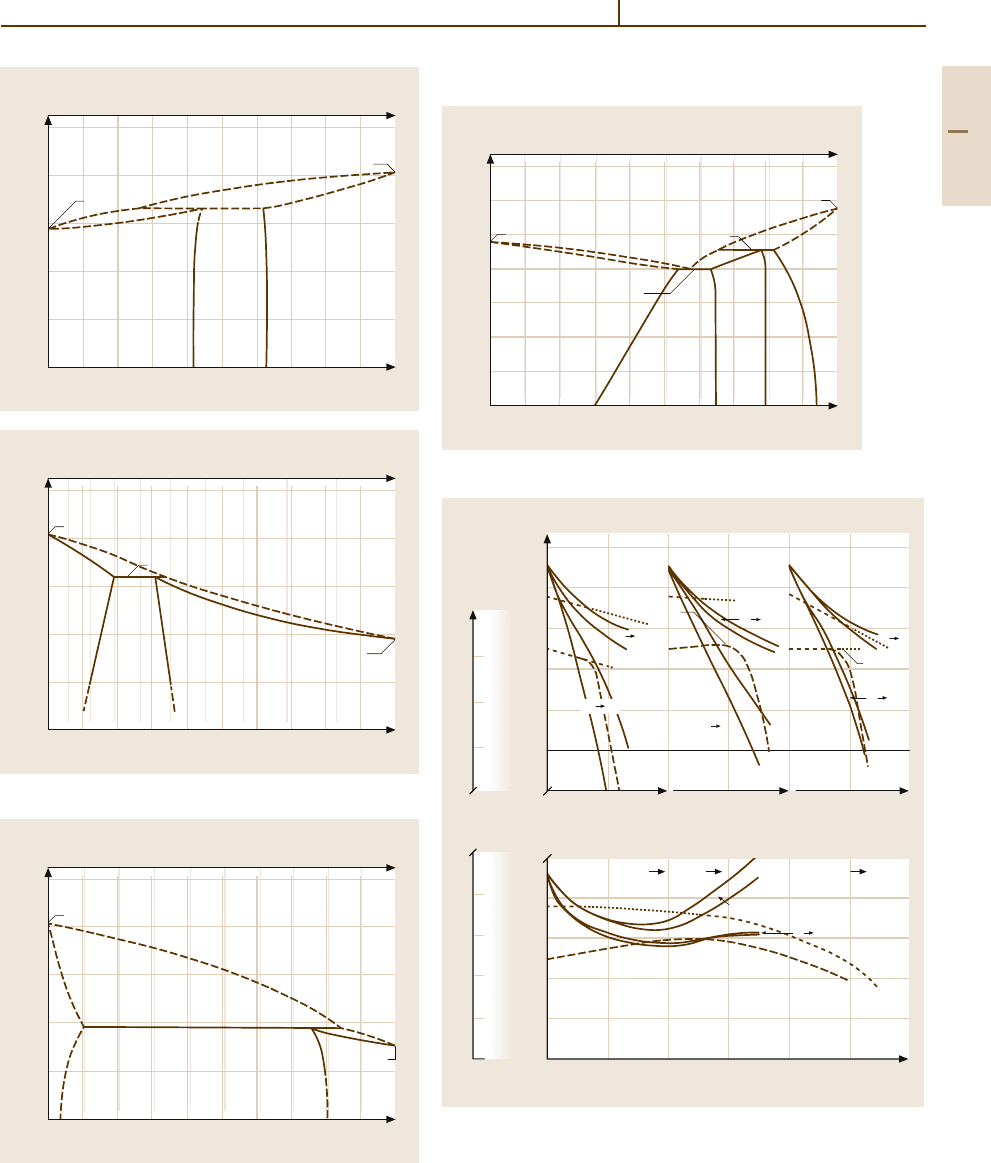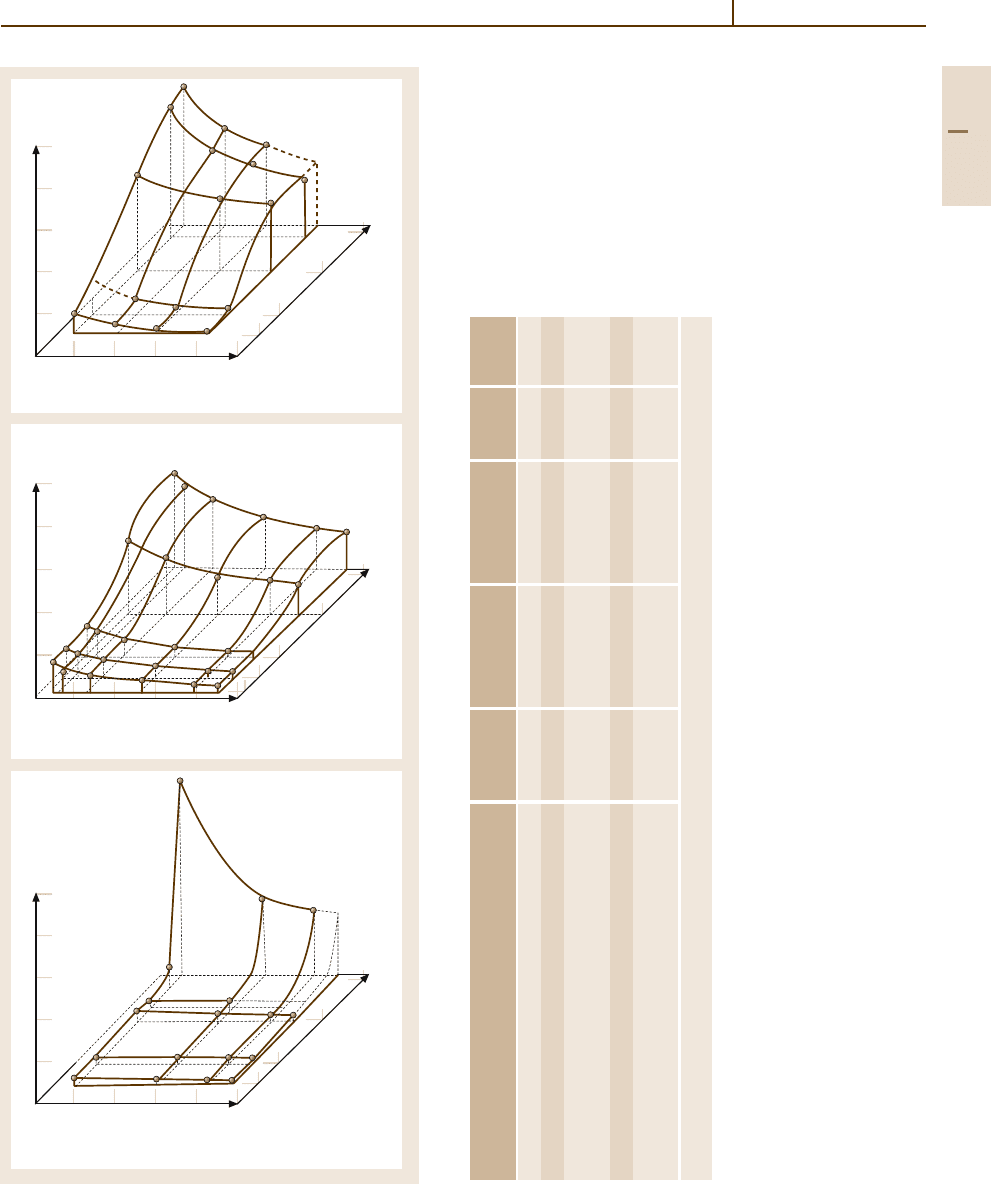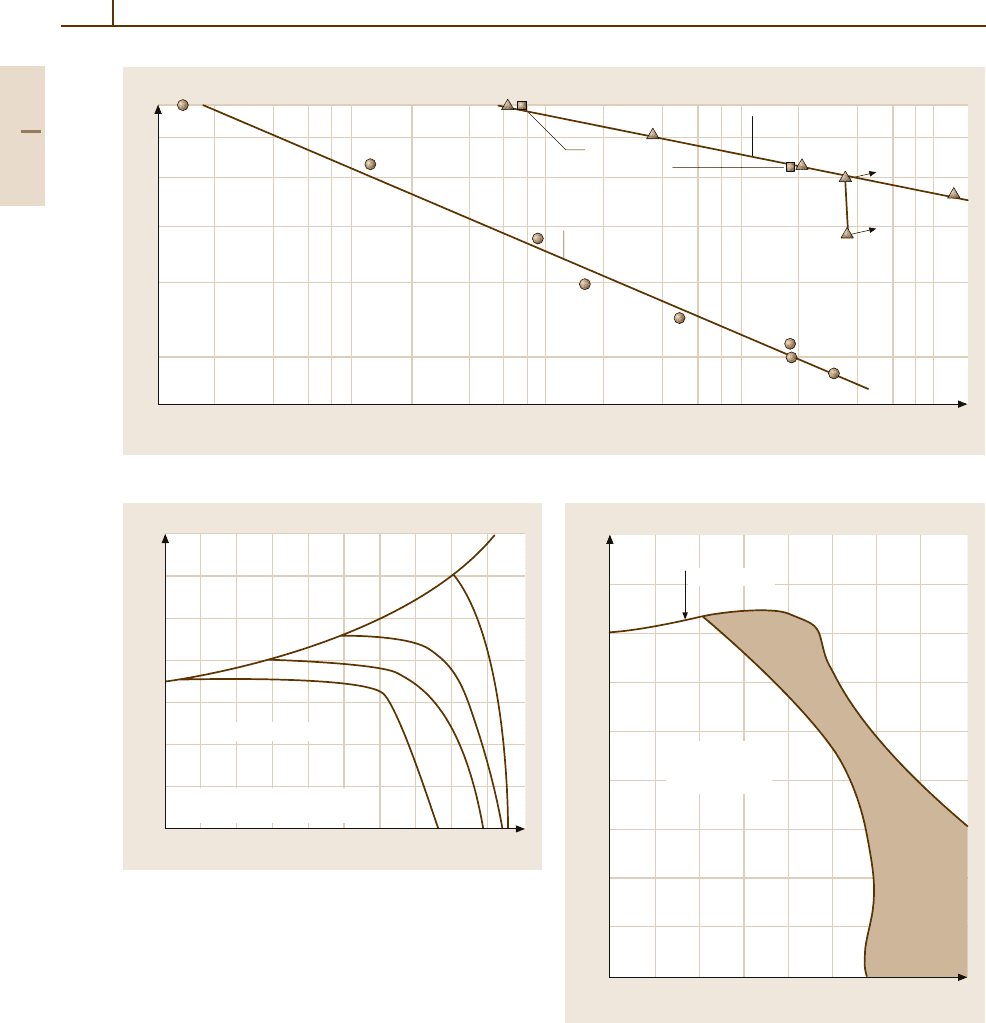Martienssen W., Warlimont H. (Eds.). Handbook of Condensed Matter and Materials Data
Подождите немного. Документ загружается.


402 Part 3 Classes of Materials
7
6.5
6
5.5
5
4.5
0 1000
Temperature (K)
200 400 600 800
χ
g
(10
–9
m
3
kg
–1
)
Fig. 3.1-337 Temperature dependence of the mass suscep-
tibility of Ru [1.217, p. 163]
Thermal Properties.
Characteristic data of thermal ex-
pansion and thermal conductivity are given in Tables
3.1-213 and 3.1-266. Figure 3.1-273 shows the vapor
pressure data for Ru.
Optical Properties. The optical reflectivity of Ru is near
that of Rh (Fig. 3.1-333). Ruthenium alloyed to Pd en-
hances the optical reflectivity by 4–5% (Fig. 3.1-275).
Diffusion. Table 3.1-217 gives some values for self
diffusion of Ru.
MeO
COOH [Ru(OAc)
2
((S)–BINAP)]
MeO
COOH
(S)-(+)-naproxen (92% yield; 97% ee)
Fig. 3.1-338 Synthesis of (S)-(+)-Naproxen catalysed by Ru-cplx
compound [1.291, p. 83]
Table 3.1-266 Thermal expansion coefficients of Ru and Os at different temperatures [1.217, p. 154]
Temperature (10
−6
K
−1
)
(
◦
C) Ru
a
Ru
b
Ru
p
Os
a
Os
b
Os
p
323 5.9 8.8 6.9 4.0 5.8 4.8
423 6.1 9.3 7.2 4.3 6.2 5.0
623 6.8 10.5 8.0 4.0 7.1 5.7
723 7.2 11.0 8.4 5.3 7.6 6.2
823 7.6 11.7 8.8 5.8 8.3 6.9
a
vertical to the crystal c axis
b
parallel to the crystal c axis
p
polycrystalline
Chemical Properties. Ruthenium is not attacked by
acids or alkali even under oxidizing conditions (aqua re-
gia). By heating in air above 800
◦
C Ru forms the oxides
RuO and RuO
2
; above 1100
◦
C Ru forms RuO
3
which
vaporizes. Detailed survey about the chemical properties
is given in [1.218, 218].
Complex organic Ru compounds are catalysts for
the enantioselective hydrogenation of unsaturated car-
boxylic acids, used in pharmaceutical, agrochemical,
flavors and fine chemicals (Fig. 3.1-338) [1.291].
Osmium and Osmium Alloys
Applications. Osmium is used as a component in hard,
wear- and corrosion-resistant alloys, as surface coat-
ings of W-based filaments of electric bulbs, cathodes
of electron tubes, and thermo-ionic sources. Osmium
itself, Os alloys, and Os compounds are strong and se-
lective oxidation catalysts. Commercial grades available
are powder in 99.6% and 99.95% purity, OsO
4
,and
chemical compounds.
Production. The production of Os starts from the
mineral osmiridium via soluble compounds and the
reduction to metal powder followed by powder-
metallurgical compacting.
Phases and Phase Equilibria. Selected phase diagrams
are shown in Figs. 3.1-339–3.1-342 [1.216]. Continuous
series of solid solution are formed with Re and Ru. Mis-
cibility gaps exist with Ir, Pd and Pt. The solid solubility
in the Os
−
W system are 48.5at.% for W and ≈ 5at.%
for Os. Osmium alloyed to Fe lowers the γ–α transition
temperature considerably (Fig. 3.1-343 [1.297]). Ther-
modynamic data are given in Table 3.1-267 [1.216] and
molar heat capacities in Table 3.1-190. Table 3.1-268
gives structures and lattice parameters of intermediate
compounds with Ir, Ru, Pt, and W [1.216].
Part 3 1.10

Metals 1.10 Noble Metals and Noble Metal Alloys 403
3500
3000
2500
2000
1500
1000
0
Os (wt %) Os
10 20 30 40 50 60 70 80 90
0
100
10 20 30 40 50 60 70 9080 100
Ir
Temperature (°C) Os (at. %)
L
(Ir)
2447°C
3033°C
(Os)
61.8
2660°C
3500
3000
2500
2000
1500
1000
0
Rh (wt %) Rh
10 20 30 40 50 60 70 80 90
0
100
10 20 30 40 50 60 70 9080 100
Os
Temperature (°C) Rh (at.%)
L
3033°C
(Os)
1963°C
(Rh)
1500°C
2600°C
1500°C
~35~12
~31
~19
Fig. 3.1-340 Phase diagram of Os
−
Rh [1.217, p. 90]
3500
3000
2500
2000
1500
1000
0
Platinum (wt %) Pt
10 20 30 40 50 60 70 80 90
0
100
10 20 30 40 50 60 70 9080 100
Os
Temperature (°C) Platinum (at.%)
L
3033°C
(Os)
1769.0°C
(Pt)
75
1955⫾15°C
Fig. 3.1-341 Phase diagram of Os
−
Pt [1.217, p. 90]
Fig. 3.1-339 Phase diagram of Os
−
Ir [1.217, p. 87]
4200
3800
3400
3000
2600
2200
1800
1400
Os
W (at. %)
10 20 30
40
50 60 70 80 90 W
10 20 30 40 50 60 70 9080
T(K) W (wt %)
L
3305 K
(Os)
(W)
78
3695 K
3218 K
≈31.5
≈64
2958 K
σ
Os–W
≈54
Fig. 3.1-342 Phase diagram of Os
−
W [1.245]
14
12
10
8
6
Magnetic
moment
in Weiß
magnetons
12
10
8
6
4
µ
w
1000
800
600
400
200
0
–200
020
Ru (at. %)
060
Rh (at. %)
800
600
400
200
10 20 10 20 10
Ir (at. %)Os (at. %)
10 20 30 40 50
Os Ir Ru
Temperature (°C)
Fe–Os
Fe–Ir Fe–Ru
ααα
α γ
α or γ
γ α
µ
w
α γ
µ
w
µ
w
α or γ
γ α
α γ
α or γ
γ α
α or γ
Fe–Rh
α
µ
w
αorγ
γ α
Fig. 3.1-343 Temperature dependence of atomic moments, γ –α
transition and magnetic transition of iron alloys [1.220, p. 259]
Part 3 1.10

404 Part 3 Classes of Materials
Table 3.1-267 Thermodynamic data of Os [1.217, p. 110]
T (K) c
p
(J/K mol) S (J/K mol) H (J/mol) G (J/mol) p (at)
298.15 24.707 32.635 0 −9.73
400 25.094 39.95 2.536 −13.444 2.95 × 10
−95
800 26.618 57.811 12.879 −33.371 6.31 × 10
−44
1400 28.903 73.287 29.535 −73.067 5.81 × 10
−22
T = Temperature, c
p
= specific heat capacity, S = Entropy, H = Enthalpy, G = free Enthalpy,
p = partial pressure of the pure elements
Table 3.1-268 Structure and lattice parameter of selected Os alloy phases [1.217, p. 118]
Phase Pearson a c Remarks Concentration x A(1−x) B(x )
symbol (nm) (nm)
Os hP2 0.27353 0.43191 293 K
Os
−
Ir hP2 0.27361 0.43417 0.35
Os
−
Ir cF4 0.38358 0.8
Os
−
Pt hP2 0.27361 0.43247 0.1
Os
−
Pt cF4 0.39094 0.8
Os
−
Ru hP2 0.27193 0.4394 0.5
Os
3
W
7
tP30 0.9650 0.4990 0.78
Mechanical Properties. Osmium is very hard and brit-
tle. The hardness is, as in the case of Ru, strongly
anisotropic. Characterisitic properties for hardness of
the element at different temperatures, as well as work
hardening and hardness of Os
−
Pt alloys are given in Ta-
bles 3.1-269 and 3.1-270 [1.216, 217] and Fig. 3.1-262.
Osmium exhibits a Young’s modulus of 570 GPa, a mod-
ulus of rigidity of 220 GPa, and the Poisson’s ratio is
0.25.
Electrical Properties. The residual electrical resistivity
ratio (273.2K/4.2 K) is 400 [1.216] (Table 3.1-203).
Table 3.1-269 Hardness of Os at different tempera-
tures [1.216]
T (
◦
C) HV
20 300–680
a
200 260–580
a
600 200–410
a
1200 130–400
a
a
all values depending on crystal orientation
Table 3.1-270 Hardness of Os
−
Pt alloys [1.217]
Pt content (wt%) HV
0 560
20 578
40 555
Table 3.1-271 Specific electrical resistivity ρ
i
(T ) (µΩ cm)
of Os at temperature T [ρ(T ) = ρ
0
+ρ
i
(T )]; (ρ
0
=
0.09 µΩ cm
a
) [1.216]
T (K) ρ
i
(µ cm)
25 0.012
100 1.90
273 8.30
900 26.0
1300 38.0
At T < 273 K; ρ
0
= 0.8 µΩ cm at T > 273 K
Table 3.1-271 [1.216] gives the specific electric re-
sistivity of Os at different temperatures. The increase
of atomic resistivity is shown in Table 3.1-263. Os-
mium coatings on W-based dispenser cathodes lower
its work function (source Ba
−
Ca aluminate). It en-
hances the secondary electron emission (Fig. 3.1-344)
and enables the operation at higher current densi-
ties in high power klystron and magnetron valves.
Osmium shows superconductivity below 0.71 K and
Table 3.1-272 gives some examples of superconducting
Os alloys [1.218].
Thermoelectric Properties. Figure 3.1-269 shows
a comparison of the thermoelectric power of the dif-
ferent noble metals of the platinum group as a function
of temperature.
Part 3 1.10

Metals 1.10 Noble Metals and Noble Metal Alloys 405
100
10
1
0.1
700 800 900
1000
1100 1200
T(°C)
j (A/cm
2
)
Os
L
Fig. 3.1-344 Current density as a function of cathodic tem-
perature for a normal cathode (dashed curve) and a cathode
with a 5 µm thick Os coating [1.298]
Magnetic Properties.
Figures 3.1-271 and 3.1-345–
3.1-347 [1.216] give a survey and present selected data
of the magnetic mass susceptibility for the element and
for Os
−
Cr alloys. This alloy system exhibits antifer-
romagnetism in compositions from 0.3 to 2.2at.%Os
in the temperature range on the left-hand side of the
bold vertical bars in Fig. 3.1-347. In Fe
−
Os alloys the
temperature of the magnetic transitionand the atomic
0.9
0.8
0.7
0.6
0.5
0.4
0.3
0.2
0 50 100 150 200 250 300
T(K)
g
(10
–9
m
3
kg
–1
)
χ
H⊥c
H c
Os
Fig. 3.1-345 Temperature depen-
dence of the mass susceptibility of
Os (single crystal) at applied magnet
field of 795–700 A/m [1.217, p. 164]
Table 3.1-272 Superconducting Os-alloys [1.218]
Os
Compound T
c
(K)
Ce3Os4Ge13 6.1
Pr3Os4Ge13 16
Nd3Os4Ge13 1.9
Eu3Os4Ge13 10.1
Tb3Os4Ge13 14.1
Dy3Os4Ge13 2.1
Er3Os4Ge13 1.9
ZrOsAs 8
HfOsAs 3.2
Y3Os4Ge13 3.9–3.7
Lu3Os4Ge13 3.6–3.1
Y5Os4Ge10 8.68–8.41
TiOsP <1.2
ZrOsP 7.44–7.1
HfOsP 6.10–4.96
magnetic moment decrease with increasing Os content
(see Fig. 3.1-343).
Thermal Properties. Data for the thermal expan-
sion coefficient at different temperatures are given in
Table 3.1-266.
Part 3 1.10

406 Part 3 Classes of Materials
0.9
0.8
0.7
0.6
0.5
0.4
0.3
0 30 60 90 120 150 180
g
(10
–9
m
3
kg
–1
)
χ
H⊥c
H c
Os
Measuring angle (deg)
α
H c
Fig. 3.1-346 Mass susceptibility of
an Os single crystal at room tem-
perature as a function of measuring
angle [1.217, p. 164]
44
43
42
41
40
39
38
37
36
35
0 100 200 300 400 500 600
T(K)
g
(10
–9
m
3
kg
–1
)
χ
Cr
0.3 at.% Os
0.6 at.% Os
1.1 at.% Os
2.2 at.% Os
Fig. 3.1-347 Temperature depen-
dence of the mass susceptibilty of
Os
−
Cr alloys. Small marks indi-
cate the Neel temperature T
N
[1.217,
p. 167]
Chemical Properties. Osmium is resistant against HCl
but is attacked by HNO
3
and aqua regia. The element
oxidizes in powder form readily at room temperature,
forming OsO
4
which vaporizes above 130
◦
C. A detailed
survey about chemical properties is given in [1.216].
The oxide OsO
4
serves as a catalyst for the synthesis of
asymmetric organic compounds. Figure 3.1-348 shows
an example for a ligand-supported chiral dihydroxyla-
tion [1.291].
cinchona alkaloid (0.13 equiv.)
NMO (1.2 equiv.)
OsO
4
(0.2 %)/Me
2
Co–H
2
O
94% ee
OH
OH
Fig. 3.1-348 Chiral dihydroxylation
using OsO
4
as catalyst compo-
nent [1.291, p. 83]
Part 3 1.10

Metals 1.11 Lead and Lead Alloys 407
3.1.11 Lead and Lead Alloys
Lead constitutes only about 12.5 wtppm (weight part per
million) of the earth’s crust, but concentrated lead ore
deposits make it easy to mine. Lead and its alloys are
used in a wide range of technical applications because
of their low melting point, ease of casting, high density,
softness and high formability at room temperature, ex-
cellent resistance to corrosion in acidic environments,
attractive electrochemical behavior in many chemical
environments, chemical stability in air, water and soil,
and the high atomic number and stable nuclear structure.
Despite their known toxicity, lead and its alloys can be
handled safely and it ranks fifth in tonnage consumed
(6 Mt/yr), after Fe, Cu, Al, and Zn. The type of data
available on different alloys depends to a great extent on
the areas of application [1.299].
The most important Pb ore mineral is galena,
(87 wt% Pb). The lead ore concentrate is roasted to form
Pb oxide. Smelting to reduce the oxide by CO produces
Pb. The lead bullion thus obtained contains Sb, As, Te,
Sn, Cu, Ni, Co, and Bi besides noble metals, and is
Table 3.1-273 Impurity levels of commercial lead grades [1.299]
Impurities, Low Bi, Refined Corroding Pure lead Chemical Copper Tellurium
additions low Ag, pure Pb
b,d
lead
e
(common lead
c,e
bearing lead
e
pure Pb
a,d
lead)
e
lead
e
L50006 L50021 L50042 L50049 L51120 L51121 L51123
(wt%) max. max.
Ag, max. 0.0010 0.0025 0.0015 0.005 0.020 0.020 0.020
Ag, min. − − − − 0.002 − −
Cu, max. 0.0010 0.0010 0.0015 0.0015 0.080 0.080 0.080
Cu, min. − − − − 0.040 0.040 0.040
Ag + Cu, max. − − 0.0025 − − − −
SbAs, Sn each 0.0005 0.0005 − − − − −
As + Sb + Sn, max. − − 0.002 0.002 0.002 0.002 0.002
Zn, max. 0.0005 0.0005 0.001 0.001 0.001 0.001 0.001
Fe, max. 0.0002 0.001 0.002 0.002 0.002 0.002 0.002
Bi, max. 0.0015 0.025 0.050 0.050
c
0.005 0.025 0.025
Te 0.0001 0.0001 − − − − 0.035–0.060
Ni, max. 0.0002 0.0002 − − − −
Pb (by difference) min. 99.995 99.97 99.94 99.94 99.90 99.90 99.85
a
For chemical applications where low Ag and low Bi contents are required
b
For lead acid battery applications
c
For applications requiring corrosion protection and formability, as per ASTM B29-92
d
As per ASTM B29-92
e
As per ASTM 749-85 (re-approved 1991)
further refined to produce various grades of lead. Com-
mercial grade pure lead is produced by the removal of
impurities through selective gas phase oxidation, pre-
cipitation from molten lead phase as pure elements, and
through the formation of intermetallic compounds with
low solubility (removal of Fe, Ni, Co, As, Te, and Sb
as oxides; precipitation of Cu as elemental Cu, CuS,
and Cu arsenates and antimonides; precipitation of Fe
as Fe arsenates and antimonides; precipitation of Ag and
Au as intermetallic compounds of Zn with Au and Ag;
Bi precipitation through the formation of a compound
CaMg
2
Bi
2
). Electrolytic refining of commercial purity
lead is used to obtain lead with purity to levels down to
99.99 to 99.9995 wt%. Zone melting is used to produce
ultrapure grades of Pb.
3.1.11.1 Pure Grades of Lead
The commercial grades of pure lead (Table 3.1-273)
are used in chemical plants, sound attenuation, roof-
Part 3 1.11

408 Part 3 Classes of Materials
Table 3.1-274 Mechanical properties of pure grades of lead [1.299–301]
Lead grade Hardness Yield Tensile Comp. Elongation Fatigue Creep
HB strength strength strength strength strength
(0.125) (25%) at 10
7
cycles (0.2%/yr)
(MPa) (MPa) (MPa) (%) (MPa) (MPa)
Pure lead (c) 4.0 5.9 13.1 15.2 45 2.7
Corroding lead, Pb > 99.94 3.2–4.5 5.5 12–13 30 3.2
Refined pure (r) 3.8 12.1 53 3.2 1.2
Chemical (c) 5.2 11.3 17.9 20.0 45
Chemical (r) 5.5 19.3 47 6.9
Undesilverized (e) 17.2 50
Undesilverized (r) 4.7 8.6 16.5 17.9 51 5.0 15.8
(r) - rolled; (c) - cast; (e) - extruded
ing, flashings and weather stripping, water-proofing, and
radiation shielding.
The mechanical properties of pure grades of lead are
listed in Table 3.1-274 [1.299–301]. The near ambient
temperatures at which lead and its alloys are used cor-
respond to high homologous temperatures (T/T
M
∼ 0.5
or higher) for lead and therefore significant diffusion
can occur. Consequently, the mechanical properties are
affected by dynamic and static recovery, recrystalliza-
tion effects, and creep deformation. Therefore, caution
is advised in the use of short-term mechanical prop-
erties. The recrystallization temperatures of different
lead grades are shown as a function cold work and
grain size in Fig. 3.1-349 [1.303]. The lowest reported
value of recrystallization temperature for 99.9999 wt%
purity lead is ∼−59
◦
C; for lead of not very high pu-
rity it is ∼−33
◦
C. The fatigue behavior of 99.99 wt%
pure lead in a Haigh push–pull test at a test cycle fre-
Table 3.1-275 Experimental values of coefficient of internal friction Q
−1
. Values in single crystal and polycrystalline
lead [1.299,302] (RT = room temperature)
Material Frequency (kHz) Q
−1
Pure polycrystalline lead 0.016–2 0.35 × 10
−2
–4×10
−2
17–28 0.2×10
−2
–0.8×10
−2
Single-crystal line lead 4–64 0.2×10
−2
–0.7×10
−2
Single-crystal Pb–0.033 wt% Sn 30 0.11 ×10
−2
(max. deformation of 10
−7
,RT)
Single-crystal Pb–0.035 wt% Bi
30 0.22 ×10
−3
(max. deformation of 10
−7
,RT)
Single-crystal Pb–0.0092 wt% Cd
30 0.9×10
−3
(max. deformation of 10
−7
,RT)
Single-crystal Pb–0.0022 wt% In
4 2×10
−3
(max. deformation of 10
−7
)
quency of 33.67 Hz is presented in the form of S–N
(stress to failure versus number of cycles) curves in
Fig. 3.1-350 [1.303].
Coefficients of internal friction of relevance to
acoustic damping are given in Table 3.1-275 [1.299,
302]. As lead is used in sound attentuation applications,
acoustic transmission data of selected single-skin and
double-skin partitions with and without lead are given
in Table 3.1-276 [1.299]. The sound reduction versus
frequency is given in [1.299,304].
Corrosion rates of lead in H
2
SO
4
and HF acids are
presented in Figs. 3.1-351 and 3.1-352 [1.301]. Cor-
rosion behavior of chemical lead in some common
environments is presented in Table 3.1-277 [1.301]. Cor-
rosion rates of the different lead grades normally fall in
the same category.
As lead is extensively used in radiation shielding, the
gamma-ray mass-absorption data for lead are presented
in Fig. 3.1-353 [1.299,305].
Part 3 1.11

Metals 1.11 Lead and Lead Alloys 409
10
8
6
4
2
0
0 20 40 60 80 100
Reduction through rolling
at 18°C (%)
50
100
200
300
10
8
6
4
2
0
0 20 40 60 80 100
Reduction through rolling
at 18°C (%)
50
100
200
300
10
8
6
4
2
0
0 20 40 60 80 100
Reduction through rolling
at 18°C (%)
50
100
200
300
18
Annealing
temperature
Annealing
temperature
Annealing
temperature
T(°C)
Grain diameter (mm)
a)
T(°C)
Grain diameter (mm)
b)
T(°C)
Grain diameter (mm)
c)
Fig. 3.1-349a–c Recrystallization diagrams: (a) Elec-
trolytic Pb.
(b) Parkes Pb. (c) Pattinson Pb [1.303]
Table 3.1-276 Acoustic transmission data of selected single skin and double skin partitions with and without lead [1.299,304]
Description of test partition Thickness Surface weight Average SRI RW STC
(mm) (kg/m
2
) (dB) (dB) (dB)
Single skin – code 1 lead sheet 0.5 5.65 22.7 25 25
Single skin – code 3 lead sheet 1.52 17.16 31.8 35 35
Single skin – 0.5 mm lead 2.17 7.94 27.4 30 30
equivalent lead impregnated PVC sheet
Double skin – 12.4 mm Gyproc plasterboard – no infill 117.76 19.04 40.2 42 41
Double skin – code 3 lead sheet bonded to 121.88 52.20 51.8 52 52
12.4 mm Gyproc plasterboard – no infill
SRI: sound reduction index; RW: weighted sound reduction; STC: sound transmission classification
Part 3 1.11

410 Part 3 Classes of Materials
10
4
80
σ
o
, σ
u
(× 981 Pa)
70
60
50
40
30
25
246810
5
2468 210
6
468 210
7
46810
8
1.5
Test with
rest intervals
in air
Cycles
Blank in air-filled
vacuum chamber
In air
In vacuum
Fig. 3.1-350 S–N (stress vs. number of cycles) curves for Pb in air and vacuum [1.303]
600
500
400
300
200
175
125
75
1.27–5.1mm/yr
50 60 70 80 90 100
T(°F)
Sulfuric acid (wt %)
0.51–1.27 mm/yr
0.127–0.51 mm/yr
> 5.1
mm/yr
0.127
0.51
1.27
5.1
0–0.127 mm/yr
Less than 0.127 mm/yr
below 50% concentration
Boiling point curve
Fig. 3.1-351 Corrosion rates of lead in H
2
SO
4
[1.301]
250
225
200
175
150
125
100
75
10 20 30 40 50 60 70 80
T(°F)
Concentration HF (%)
Corrosion
rates
more than
0.51 mm/yr
Corrosion rates
less than
0.51 mm/yr
Boiling point
Fig. 3.1-352 Corrosion rates of lead in HF [1.301]
Part 3 1.11

Metals 1.11 Lead and Lead Alloys 411
Table 3.1-277 Classifying corrosion behavior of Pb in selected environments [1.301]
Chemical Temperature (
◦
C) Concentration (wt%) Corrosion class
Acetic acid 24 Glacial B
Acetone 24–100 10–90 A
Acetylene, dry 24 − A
Ammonia 24–100 10–30 B
Ammonium azide 24 − B
Ammonium carbonate 24–100 10 B
Ammonium chloride 24 0–10 B
Ammonium hydroxide 27 3.5–40 A
Ammonium nitrate 20–52 10–30 D
Ammonium phosphate 66 − A
Ammonium sulfate 24 − B
Arsenic acid 24 10 B
Benzene 24 − B
Boric acid 24–149 10–100 B
Bromine 24 − B
Butane 24 − A
Carbon tetrachloride (dry) BP 100 A
Chlorine 38 − B
Citric acid 24–79 10–30 B
DDT 24 − B
Fluorine 24–100 − A
Hydrochloric acid 24 0–10 C
Hydrogen chloride (anh HCl) 24 100 A
Mercury 24 100 D
Methanol 30 − B
Methyl ethyl ketone 24–100 10–100 B
Phosphoric acid 24–93 − B
Sodium carbonate 24 10 B
Sodium chloride 25 0.5–24 A
Sodium hydroxide 26 0–30 B
Sodium nitrate 24 10 D
Sodium sulfate 24 2–20 A
Sulfur dioxide 24–204 90 B
Natural outdoor atmospheres 24 −A
Industrial, natural and domestic waters 24 −A
Soils 24 −A
Data mostly correspond to chemical lead. The four corrosion performance categories:
A < 0.051 mm/yr: Negligible corrosion – lead recommended for use;
B < 0.51 mm/yr: Practically resistant – lead recommended for use;
C = 0.51–1.27 mm/yr: Lead may be used where this effect on service life can be tolerated;
D > 1.27 mm/yr: Corrosion rate too high to merit any consideration of lead
Part 3 1.11
